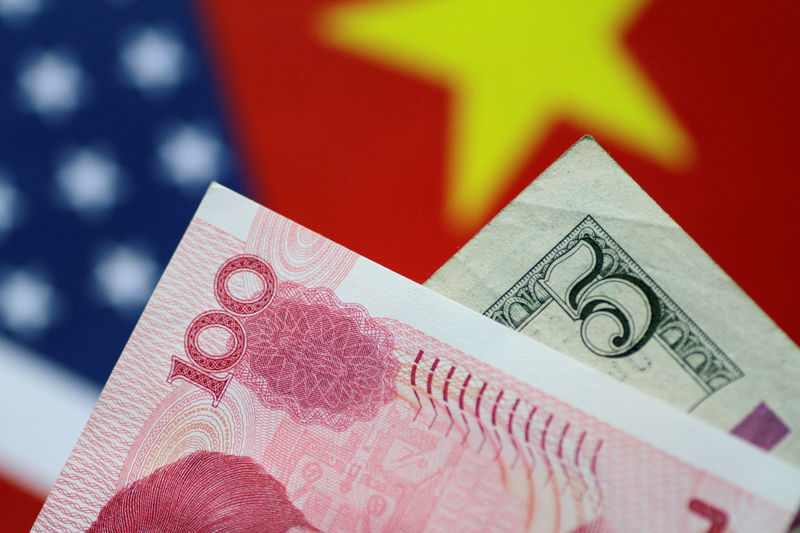By Andrew Galbraith and Winni Zhou
SHANGHAI (Reuters) - Chinese government bond yields and stocks rose on Tuesday after Beijing vowed to pursue a more 'vigorous' fiscal policy, as authorities stepped up efforts to support growth amid rising economic headwinds.
Expectations of further loosening in monetary conditions drove the offshore yuan down to a 13-month low, and underscored a broad change in China's policy direction as fears grow that an increasingly heated Sino-U.S. trade war could deal a harsh blow to the economy.
"The government is sending a clear signal that it is preparing to defend growth, ... Premier Li may be concerned about the negative impact of deleveraging on growth," ANZ economists Raymond Yeung and Betty Wang said in a note.
The yield on 10-year Chinese government bonds (CN10YT=RR) ended 2.9 basis points higher at 3.562 percent.
The rise follows a steady decline in the yield on 10-year treasury bonds, fueled by robust demand. The yield has fallen more than 50 basis points since late January, according to Thomson Reuters data.
As the U.S. Federal Reserve looks set to raise rates twice more this year, investors have pulled out of the yuan and other global currencies. The spread between 10-year Chinese and U.S. Treasuries has narrowed sharply, touching 19-month lows on Thursday.
Borrowing costs globally jumped on Tuesday after speculation that the Bank of Japan is close to announcing measures to dial back monetary stimulus.
On Monday, the State Council, China's cabinet, said the country would adopt a more 'vigorous' fiscal policy, while in an unexpected move, China's central bank lent 502 billion yuan ($74.36 billion) to financial institutions via its one-year medium-term lending facility (MLF), stepping up efforts to support lending as growth slowed.
The State Council's statement also indicated plans to accelerate the issuance of 1.4 trillion yuan in special bonds by local governments to underwrite investment in infrastructure, meaning the supply boost is likely to weigh on bond prices.
The shift in focus toward easing also comes after the central bank in July released 700 billion yuan in liquidity by cutting some banks' reserve requirements, prompted by concerns over tighter cash conditions and a potential economic drag from the U.S. trade dispute. It was the third such cut this year.
Economists have not ruled out further reserve requirement reductions this year.
While China has for now ruled out broad monetary loosening amid a multi-year effort to combat excessive financial risks, the country's economic data showed signs of weakness even before the latest ratcheting up of trade war tensions.
The world's second-largest economy grew more slowly in the second quarter and June factory output growth weakened to a two-year low, pointing to weaker exports and investment.
On Tuesday, a trader at an Asian bank in Shanghai said bond market sentiment was weak, and that market players remained divided over the outlook for rates.
As investors sold bonds, the country's stock markets moved higher on the prospect of policy easing. The Shanghai Composite index (SSEC) and the blue-chip CSI300 index (CSI300) both closed up 1.6 percent.
Shanghai's benchmark index and the CSI300 remain the world's worst-performing major stock indexes this year, but some investors say that fears of a rout in Chinese markets are overdone.
On top of the policy easing, analysts also cited new rules governing financial institutions' wealth management and asset management businesses for the jump in shares, noting they were less stringent than expected and would help to reduce systemic risks.
The long-awaited wealth management rules, released on Friday, aim to push banks to standardize their wealth management businesses and to invest wealth-management product funds into the capital markets in a compliant way.
YUAN WEAKNESS
In the currency market, expectations of further policy easing piled pressure on a fragile yuan, which suffered its worst month on record in June. The spot market
If the onshore yuan finishes the late night session at the same level, it would have lost 0.36 percent against the dollar for the day. The offshore yuan
The People's Bank of China (PBOC) had set the midpoint rate
On Monday, China said it has no intention of devaluing the yuan to help exports, after Washington said it was monitoring the currency's weakness amid the escalating bilateral trade brawl.
"The market now believes that chances for the yuan to rebound are getting low, unless there would be a strong official guidance from the authorities. Tolerance is higher. Investors thought that the 6.7 per dollar was the floor, then 6.8, now both are gone," said a trader at a foreign bank in Shanghai.
She said current trade suggested the authorities remained comfortable with the losses in the currency.
